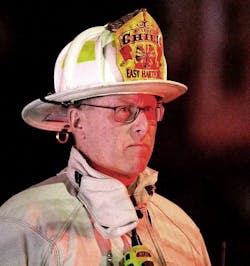FireFusion Preview: Technology for Incident Command & Operations Training
Day 1
On the first day of FireFusion, a variety of short and in-depth sessions will cover numerous fire service technology topics, from product and concept introductions to data. An interactive incident command simulation session will be offered to a limited number of attendees, too.
The two-hour Tailboard Talk session will bring together industry innovators and fire service leaders to discuss the latest concepts in fire service technology as well as to look into the future of fire service technology in a series of short, high-impact discussions. Following these discussions, attendees will break out into a number of Think Tank sessions, which will be moderated by firefighters, officers, chiefs and/or manufacturers, to host engaging group conversations and to help to answer attendees’ questions and to map the future of their department.
One often-overlooked element of recent innovations in the fire service is data. It can be overwhelming and misunderstood, because many firefighters and fire service leaders don’t know what to do with data.
In the detail-packed “How to Avoid Drowning in a Pool of Fire Service Data,” Fire Chief John Oates (Ret.) will guide attendees on how they can provide explanations about how their community is affected by fire. Among the data points that attendees will work to understand during the interactive, open-learning session: how the department is performing and the costs of service delivery.
A three-hour session, “Incident Command Simulations,” will allow attendees to utilize the Fire Chief Tom Carr Command Training Center, which is located next to the Charleston 9 Memorial site. Attendees will spend the morning engaged in incident command scenarios using computer-generated incidents to build teamwork skills, with a focus on commanding emergency scenes and proper radio traffic. Preregistration is required for this session.
Days 2 & 3
Over the second and third days of the event, education sessions will be interlaced with time that attendees can spend in the FireFusion Marketplace, which will be staffed by technology and innovation service providers and equipment manufacturers.
Among the sessions that will convene on these days: best practices on implementing technology into today’s public safety agencies and at emergency scenes, and innovations in training.
Andy Bozzo, who is a California battalion chief, will present “The Importance of Standardized Incident Command Using Technology.” He will show incident commanders the benefits of technology while managing an incident.
Bozzo founded one of the first incident command software companies following the death of two firefighters in his department at a structure fire. The intent of his endeavor is to streamline management, including resource management, situational awareness and incident mitigation.
During his presentation, Bozzo will look at the innovations that he has witnessed and how departments use a variety of technology at their command posts.
Virtual reality (VR) isn’t something that’s coming to the fire service; the innovations already are in place at departments across the United States, enhancing training and allowing for a variety of scenarios to be carried out.
In “Leveraging Virtual Reality for Fire Service Training,” Mike Novak and Fred Caserta will look at how training officers can provide hands-on training in controlled situations without exposing students to risks, to enhance critical skills, such as decision-making, while fostering the development of muscle memory. VR allows training officers to monitor individual performance and tailor training programs accordingly. The session will include a live demonstration for attendees, who will watch participants perform training evolutions using VR.
Sean DeCrane, who represents the International Association of Fire Chiefs and UL’s FSRI, will provide a look at how various battery and stored-energy systems affect today’s fireground responses. From lithium-ion batteries to energy-storage systems, DeCrane will share the latest findings from the field on the dangers that firefighters face from these products and how to mitigate emergencies that involve them.
Andy Starnes will look at the most common piece of handheld technology that’s employed on firegrounds these days—thermal imaging cameras (TICs)—in “Tactical Thermal Imaging: 10 Tips for Thermal Imaging Success.” Starnes will be focused on helping attendees to understand the various functions of TICs in this interactive session, which also includes demonstrations on TIC operations for every level of user.
From FDNY’s Robotics Unit, Capt. Mike Leo will share how the largest fire department in the United States embraced a variety of robotics to enhance responses. His presentation will include two case studies of large-scale incidents. Leo will highlight how drones and other equipment helped incident commanders to make decisions that were based on data that were collected from above street level using numerous types of equipment.
During “Innovations in Technology for Fire Service Training,” Tal Prendergast and Ed Levy will explain how the Illinois Fire Service Institute has employed various technology-
driven tools to enhance and grow its educational offering to firefighters from around the state.
On Nov. 6, an afternoon town hall will feature key fire service leaders who will speak to the future of technology in emergency services, key benchmarks for innovation rollouts and how the recently announced National Emergency Response Information System (NERIS) will push the U.S. fire service forward when it comes to making the case for investments, funding and technology rollouts. Preregistration is required for this session.
A walking tour of Charleston’s historic downtown will be interlaced with the Charleston Fire Department’s (CFD) leadership development program on Nov. 7. With limited spots, the three-hour Leadership Walking Tour will stop at three fire stations, where CFD firefighters will discuss leadership components as they relate to the unique challenges that emergency services face today. The members will discuss how changes led to the department becoming a progressive organization and how this evolution in mindset can help your department to do the same.
2007 Sofa Super Store Fire Brings Technology to Charleston Area
Following the devastating Charleston Sofa Super Store fire on June 18, 2007, which claimed the life of nine firefighters, the U.S. fire service watched as the department changed the way that it operated. From updating equipment, training and operations to using technology to remove response borders around the Charleston area, the region now is a model for best practices for how technology and collaboration can bring agencies together to enhance response capabilities.
Throughout the FireFusion conference, the Sofa Super Store fire and the effect that the tragedy has had on the region and on the national fire service will be the focus of several sessions.
On Nov. 6, Firehouse’s Leadership Lessons columnist, Dr. David Griffin, who was on the first-due engine to the fire, will present “From the Ashes …” He and others will discuss what happened at the Sofa Super Store fire and how the organization has changed in the past 17 years.
As a result of growth and retirements, almost 400 members of the Charleston Fire Department weren’t on the job at the time of the tragedy, and it has been the duty of Griffin and fellow members to teach the newest firefighters about the fire and the lessons learned. This keynote program will look at the successes and failures and where the department will go in the future.
Also on Nov. 6, Charleston Fire Chief Dan Curia, North Charleston, SC, Fire Chief Greg Bulanow (Ret.) and Jim Lake, who is 9-1-1 coordinator & center director for the Consolidated Emergency Communications Center, will discuss the collaboration between fire departments in Charleston County. Using technology, data-sharing, consolidated dispatch and response innovations has transformed the landscape of fire protection in the Charleston area, and this panel will share the means to model these successes.
There is limited availability for two walking tours of the Charleston Sofa Super Store fire site as the main FireFusion program ends on Nov. 7. Join firefighters who were at the scene as they walk you through the events of that historic fire service tragedy at the Charleston 9 Memorial site. Learn about the response, the building layout and construction, operations and where each firefighter lost his life during the attempt to rescue citizens and control the fire. Preregistration is required for these sessions.
About the Author
Peter Matthews
Editor-in-Chief/Conference Director
Peter Matthews is the conference director and editor-in-chief of Firehouse. He has worked at Firehouse since 1999, serving in various roles on both Firehouse Magazine and Firehouse.com staffs. He completed an internship with the Rochester, NY, Fire Department and served with fire departments in Rush, NY, and Laurel, MD, and was a lieutenant with the Glenwood Fire Company in Glenwood Landing, NY. Matthews served as photographer for the St. Paul, MN, Fire Department and currently is a photographer for the Fort Worth, TX, Fire Department.

